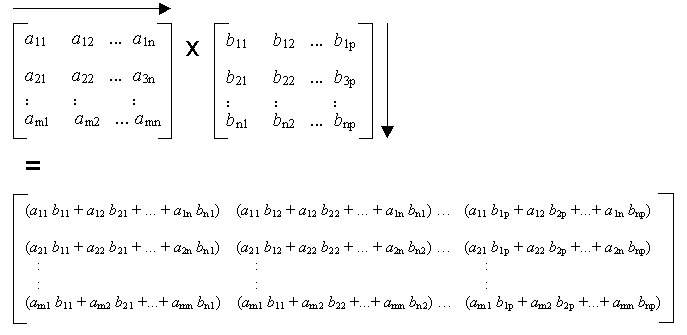- Use a built-in matlab function:
< o = ones(5,3) > creates a matrix of 1's with 5 rows and 3 columns.
NB: An m x n matrix has m rows and n columns. (Rows first, then columns.)
< r = rand(4,4) > creates a matrix of random numbers with 4 rows and 4 columns.
Enter an explicit list of elements using square brackets [ ]:
< m1 = [2 3 4] > creates a matrix with 1 row and 3 columns.
< m2 = [5; 6; 7] > creates a matrix with 3 rows and 1 column (the semicolon separates the rows).
< m3 = [1 1; 3 3; 5 5] > creates a matrix with 3 rows and 2 columns.
- Load a matrix from a space- or tab-delimited file:
Type the following into the editor (use spaces or tabs between the numbers) -
16 3 2 13 5 10 11 8 9 6 7 12 4 15 14 1
Save this as a file called magic1.dat and load it into matlab using the command< load magic1.dat >
The matrix will now be in your workspace, type < magic1 > to see it.
Every entry of the matrix is multiplied separately by the scalar.

Multiply the matrix < m3 > by 4 and call it < m4
>.
Divide < m4 > by 2.
The elements of each matrix
are multiplied by the corresponding element in the other matrix
which must
have the same shape.
- Use the < .* > notation to multiply
element-by-element the < magic
> matrix and the
< r > matrix (they should be in your workspace). - Create a 4x4 matrix of ones and multiply it by the scalar 8 - call it < m5 >.
- Make a new matrix < m6 > by doing the element-by-element cube
root on < m5 >.
(Hint - to get the square root you raise to the power 1/2.) - Make a new matrix < halfmagic > by doing element-by-element divide < magic1 > by < m6 >.
Two matrices can only be multiplied if the number of columns in the first is
equal to the
number of rows in the second.
If matrix A has m rows and n columns: A(m,n)
and matrix B has n rows and p columns: B(n,p)
then their product, matrix C, has m rows and p columns:
A(m,n) x B(n,p) = C(m,p)
Each
element in the first row of A is multiplied by the
corresponding element in the
first column of B and the products
added to give the first element of C:
c11 = (a11*b11 + a12*b21 + a13*b31 + ... a1nbn1)
Similarly,
the next element of C in the first row is given by the sum of the products
of the elements in the first row of A and the second column of B.

For example:

On
paper, try multiplying the following pairs of matrices.
Then check if you
are correct using matlab.


To access an element in row 3 and column 2 of matrix A type < A(3,2) >.
- Use the colon operator < : > to access the first column of the matrix < magic1 >.
- What is the element in row 3, column 5 of the matrix < o > in your workspace?
- Use the colon operator and the empty matrix < [] > to delete the last row of < r >.
| < sum > | sums the elements of a matrix column-wise |
| < rot90 > | rotate a matrix by 90— |
| < flipud > | flip matrix upside-down |
| < fliplr > | flip the matrix left-right |
| < diag > | extracts matrix elements on the main diagonal (top left to bottom right) |
- In matlab the transpose of a matrix A is denoted by A'.
What is the transpose of the
magic square < magic1 > ? How does it relate to the original matrix? - Calculate the column-wise sums of the matrix < magic1 > and its transpose.
- Find the sum of the elements on the main diagonal of < magic1 >.
- What then are the properties of a magic square?